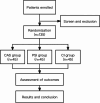Evaluating the clinical outcomes of computer-assisted surgery and patient-specific instrumentation compared to conventional instrumentation in total knee arthroplasty, a randomised controlled trial
- PMID: 40804671
- PMCID: PMC12351897
- DOI: 10.1186/s12891-025-08980-7
Evaluating the clinical outcomes of computer-assisted surgery and patient-specific instrumentation compared to conventional instrumentation in total knee arthroplasty, a randomised controlled trial
Abstract
Objective: Computer-assisted surgery (CAS) and patient-specific instrumentation (PSI) are digital techniques to improve the accuracy of implant positioning in total knee arthroplasty (TKA), but their effects on clinical outcomes are still in dispute. The objective of this trial is to evaluate the efficacy and safety of CAS and PSI compared to conventional instrumentation (CI) in TKA.
Methods: A prospective randomized controlled trial was conducted. A total of 135 patients undergoing TKA were randomized into CAS group, PSI group and CI group with 45 patients in each group. Primary outcome is the coronal mechanical axis of lower extremity. Secondary outcomes include Femoral Rotation Angle (FRA) of the femoral prosthesis, operation time, perioperative blood loss, Western Ontario and McMaster Universities Osteoarthritis Index (WOMAC), Forgotten Joint Score (FJS) and complications.
Results: Outliers of Hip-Knee-Ankle angle (HKA) were 24.4% in CI group, 17.8% in CAS group and 31.1% in PSI group respectively, and there was no significant difference among these 3 groups (P > 0.05). Outliers of FRA were 13.3% in CI group, 26.7% in CAS group and 11.1% in PSI group respectively with no significant difference (P > 0.05). Operation time was (66.67 ± 12.85)min, (81.67 ± 12.31)min and (52.78 ± 8.62)min in CI, CAS and PSI group. Operation time in CI was longer than PSI and shorter than CAS with significant difference (P < 0.01). There was no significant difference in comparison of blood loss, transfusion rate, postoperative WOMAC and FJS (P > 0.05).
Conclusion: CAS and PSI, compared with CI, did not significantly improve clinical outcomes including lower limb alignment, rotation of femoral prosthesis, blood loss, transfusion rate, and function scores. However, CAS was associated with prolonged operation time, whereas PSI resulted in a reduced operation time.
Level of evidence: Level II.
Trial registration: ChiCTR-INR-17,012,881 (registration date: 03/10/2017).
Keywords: Computer-assisted surgery; Patient-specific instrumentation; Total knee arthroplasty.
© 2025. The Author(s).
Conflict of interest statement
Declarations. Ethics approval and consent to participate: This study is conducted in accordance with the Declaration of Helsinki and is approved by Peking University Third Hospital Medical Science Research Ethics Committee (Registration number: IRB00006761-2016064). All the participants have signed the informed consent. Competing interests: The authors declare no competing interests.
Figures
Similar articles
-
Bicruciate-stabilized TKA Does Not Result in Improved Patient-reported Outcomes Compared With Posterior-stabilized TKA: A Randomized Controlled Trial in Bilateral Simultaneous TKA.Clin Orthop Relat Res. 2025 Feb 19;483(8):1456-1468. doi: 10.1097/CORR.0000000000003423. Clin Orthop Relat Res. 2025. PMID: 39982035 Clinical Trial.
-
Systematic review of patient-specific instrumentation in total knee arthroplasty: new but not improved.Clin Orthop Relat Res. 2015 Jan;473(1):151-8. doi: 10.1007/s11999-014-3804-6. Clin Orthop Relat Res. 2015. PMID: 25059850 Free PMC article.
-
Are There Differences in Accuracy or Outcomes Scores Among Navigated, Robotic, Patient-specific Instruments or Standard Cutting Guides in TKA? A Network Meta-analysis.Clin Orthop Relat Res. 2020 Sep;478(9):2105-2116. doi: 10.1097/CORR.0000000000001324. Clin Orthop Relat Res. 2020. PMID: 32530896 Free PMC article.
-
Favourable alignment outcomes with MRI-based patient-specific instruments in total knee arthroplasty.Knee Surg Sports Traumatol Arthrosc. 2018 Sep;26(9):2659-2668. doi: 10.1007/s00167-017-4637-0. Epub 2017 Jul 11. Knee Surg Sports Traumatol Arthrosc. 2018. PMID: 28698929
-
Better radiological outcomes but equal clinical function of a novel knee arthroplasty robot system: a prospective randomized controlled trial.Int Orthop. 2025 Jul;49(7):1679-1687. doi: 10.1007/s00264-025-06523-2. Epub 2025 Apr 23. Int Orthop. 2025. PMID: 40266310 Clinical Trial.
References
-
- Sharkey PF, Hozack WJ, Rothman RH, Shastri S, Jacoby SM. Why are total knee arthroplasties failing today? Clin Orthop Relat Res. 2002. 10.1097/00003086-200211000-00003. - PubMed
-
- Miller MC, Berger RA, Petrella AJ, Karmas A, Rubash HE. Optimizing femoral component rotation in total knee arthroplasty. Clin Orthop Relat Res. 2001. 10.1097/00003086-200111000-00005. - PubMed
-
- Olcott CW, Scott RD. The Ranawat award. Femoral component rotation during total knee arthroplasty. Clin Orthop Relat Res. 1999; (367):39–42. - PubMed
-
- Jones CW, Jerabek SA. Current role of computer navigation in total knee arthroplasty. J Arthroplasty. 2018;33:1989–93. - PubMed
Grants and funding
LinkOut - more resources
Full Text Sources
Research Materials


